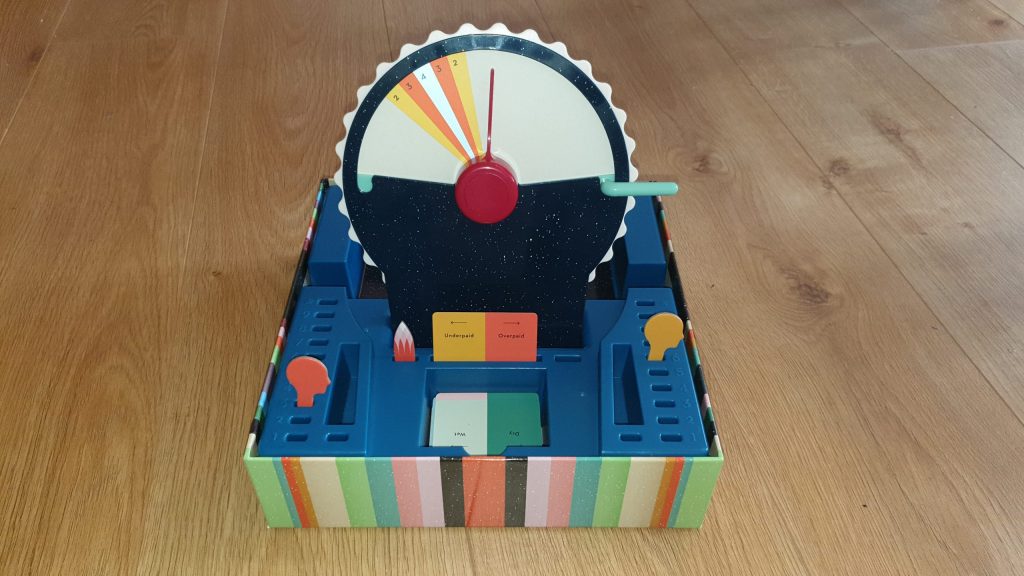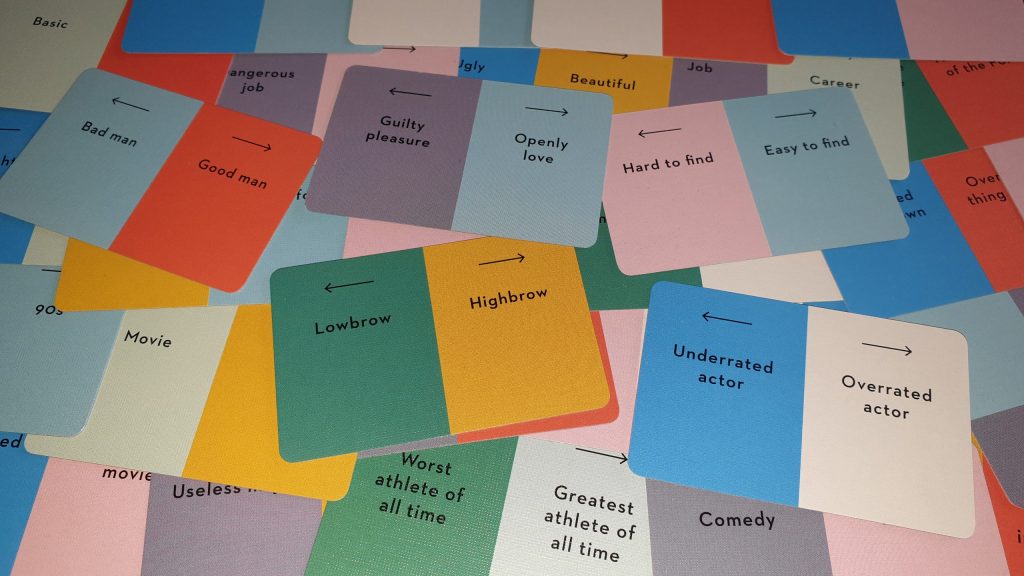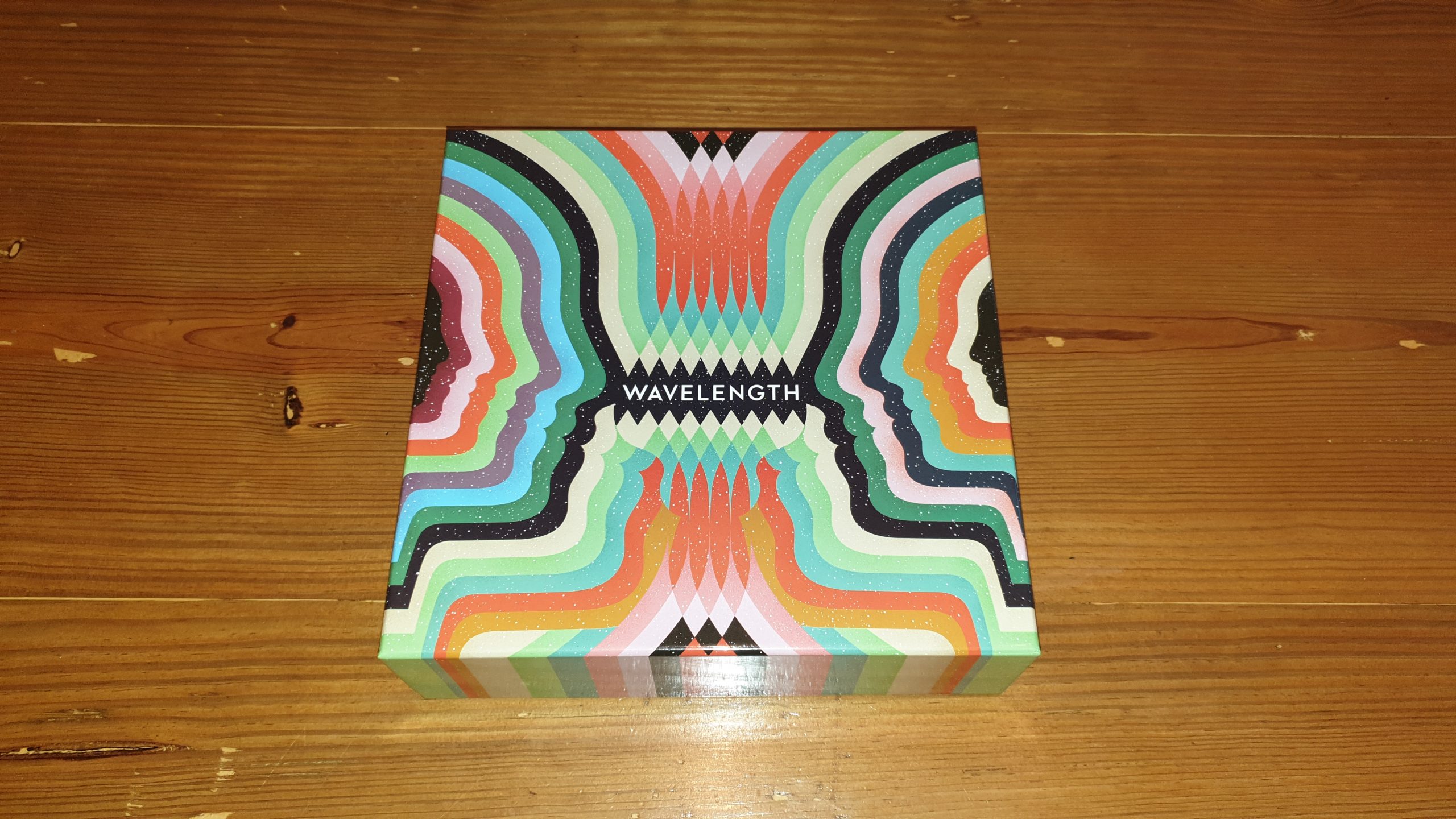Wavelength is a brand new team based party game from publisher Palm Court, designed by Alex Hague, Justin Vickers and Wolfgang Warsch. After a successful Kickstarter, somewhat driven by Warsch being one of the designers, the game is now hitting retail. Playing with up to 12 players, the teams will come up with clues and bet on being on the same wavelength as their friends and family. Putting aside the current world situation that limits the ability to play the game, do players need to be psychic to enjoy the experience? Let’s find out!
Wavelength hardly needs to be unboxed to be played. Setup is as minimal as opening the box, standing the dial up in the box and shuffling the cards. Splitting into two teams, as evenly as possible, players choose one team to start. To balance things, while the starting team puts their point tracker on zero, the second team starts on one point.
On a team’s turn they nominate a player to be the psychic. The role of the psychic is effectively the clue giver of the round, with all players needing to pay attention. The psychic picks up the dial and uses the waved edge to secretly give it a spin. Only the psychic player sees where the target wavelength is. This is guaranteed by closing the guard so no one else can see the target. The dial is then placed back into its standing box position. Drawing a card the psychic reads both sides before choosing a binary pair to work with. For example, the binary pair could be Requires Luck – Requires Skill each indicating one end of the dial’s spectrum.
The round is now fully ready with the psychic able to give a clue, related to the binary pair on the card. As an example, using the binary pair of Casual to Formal the clue might be a top hat to indicate the target wavelength is towards the Formal end of the spectrum, or non-ripped jeans to suggest being somewhere in the middle. The psychic’s team must interpret the clue, and turn the dial marker to where they think on the spectrum the clue would sit. The opposing team now gets a chance to state which end of the spectrum they believe the target wavelength is closer to from the dial marker.

Revealing the target, by lifting the guard, everyone then sees how well the guessing team did. Scoring for the guessing team is based on how accurately they guessed. The bullseye of the target is worth 4 points, with zones reducing in 1 point steps down to blank zero point sections. The guessing team gains as many points as indicated on the dial – based on where the dial marker was. The non-guessing team then gains a single point if they correctly stated that the bullseye was further towards the side they indicated.
If the team gained all 4 points being successfully in the bullseye zone the non-guessing team doesn’t gain any points. On top of this, as an obvious catch up mechanic, if the perfect 4 points are scored and the team is still behind they get another go. Otherwise, the game continues with the other team getting a turn, ending when one team reaches 10 points. The catch up mechanic however nicely allows there to always be an opportunity to win, regardless of how pitifully a team is doing.
Stepped through in an extremely logical way, learning the game via the rulebook is a breeze. Not only does it lay out an example round but also give suggestions of types of clues. While some of the rules are often bent a little, like only using a single thought, they are mostly there to keep things on a level playing field and not to hamper creativity. For example, injokes within a team are effectively banned. It’s fine if everyone is in on the joke, just no one wants to feel sidelined and left out in a party game!
Setting up the game to have an epic table presence is the box itself (and the insert). Including the scoring tracks, a card holder and allowing the dial to be almost upright all combine to be a self contained and eye catching production. Aside from the visual appeal, this design enables the game to be played almost anywhere, with the dial always easy to see for all players. A table isn’t always needed as the box can sit nicely on the floor amongst people and still be seen.

One aspect of the experience that can be awkward at first is the guard that slides shut. It sort clicks into place when closed, so it doesn’t mistakenly open. The first time new players get hands on with this though they struggle to open it, almost scared to break it by pulling too hard. It doesn’t need pulling hard, just a purposeful pull. As long as new players know this and no-one nudges the dial when they do this then everything runs smoothly. This “issue” ebbs away quickly, being more something to make players aware of than a problem.
Making the wavelength cards double sided was a genius move to not only double the perceived content but to allow all players to feel comfortable playing. Roughly these cards are normal on one side and more on the silly on the reverse, with the psychic player able to choose which to go for. An additional benefit, if a player is stumped of what they could say by one side, flipping it over might help trigger an idea that could work. This smooths the experience out, reducing the thinking time for those in the psychic role for the round, and reducing the pressure that comes with it.
Individual games take around 20 – 30 minutes but often this isn’t the end of Wavelength. Chances are players won’t be wanting to pack away, instead just resetting for another game. As with many party games the experience is more about the laughs and entertainment along the journey, than the actual winning. Even when it is put back on the shelf Wavelength will have caused many talking points, from the shock of peoples seeming hatred of KFC to the ridiculous idea the sun isn’t more than just slightly warm… Inevitably these get resurfaced after the game ends, and for days to come. Therefore, for the conversations that can be caused and the odd and miraculous things people say as part of playing Wavelength, it’ll be continually brought out at gatherings – at least when they are allowed once again!
(Editor’s Note: Wavelength was provided to us by Asmodee for the review. The game is currently available from local board game stores, which some are doing delivery services, find your local store here.)

